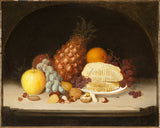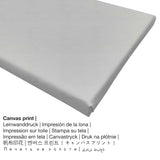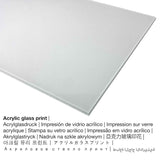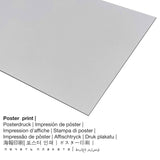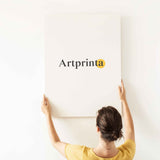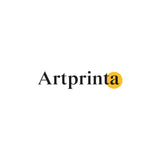Robert S. Duncanson, 1849 - Martwa natura - druk artystyczny
Podatek jest wliczony. Koszt wysyłki zostanie obliczony W kasie.
Który materiał produktu najbardziej Ci się podoba?
W menu rozwijanym produktu możesz wybrać swój ulubiony materiał i rozmiar. W ramach indywidualizacji dostępne są następujące opcje:
- Obraz na szkle akrylowym (z powłoką z prawdziwego szkła): A glossy print on acrylic glass, which is sometimes labelled as a an art print on plexiglass, will change your favorite original artwork into great décor. Your artwork is being custom-made thanks to the help of modern UV print machines.
- Plakat (materiał płócienny): The poster is a printed sheet of canvas paper with a slight structure on the surface, which resembles the actual artwork. A printed poster is used for placing your art copy using a custom frame. Please bear in mind, that depending on the absolute size of the poster print we add a white margin between 2-6 cm round about the painting, which facilitates the framing with your custom frame.
- Wydruk na płótnie: The canvas direct print is a printed cotton canvas mounted on a wooden frame. A canvas has a typical impression of three-dimensionality. The canvas print creates a charming and comfy atmosphere. Canvas prints are relatively low in weight, which implies that it is easy to hang up your Canvas print without the use of additional wall-mounts. A canvas print is suited for any type of wall.
- Nadruk metalowy (dibond aluminiowy): These are metal prints on aluminium dibond with an impressive depth. For the Direct Aluminium Dibond option, we print your selected artpiece right onto the surface of the aluminum material.
Ważna uwaga: We try to describe our art products as precisely as possible and to demonstrate them visually. Nonetheless, the colors of the print products, as well as the print result can diverge slightly from the presentation on the screen. Depending on the screen settings and the quality of the surface, not all color pigments will be printed as exactly as the digital version on this website. Since all art reproductions are printed and processed manually, there might as well be minor discrepancies in the exact position and the size of the motif.
Oryginalne informacje o dziełach sztuki z Muzeum Sztuki Hrabstwa Los Angeles (© - Muzeum Sztuki Hrabstwa Los Angeles - www.lacma.org)
Still-life paintings are rare in Duncanson’s oeuvre. Seven canvases are known today. The decorations Duncanson created from 1848 to 1850 for Belmont, the home of his patron Nicholas Longworth (now the Taft Museum, Cincinnati), may have stimulated his interest in such subject matter. Although painted in a different, more rococo style, the decorative panels included two overdoor designs of fruit and flowers in vases. Longworth was not only a lawyer and a major patron of the arts but one of the finest horticulturists in America. He played a major role in the commercialization of grapes and cultivation of strawberries. However, in none of Duncanson’s located still, lifes did the artist focus on grapes. Rather, in the fashion of most still-life specialists, he included a variety of food: apples, grapes, oranges, raisins, nuts, pineapples, and honeycombs. The last two items were considered exotic and often were included in Victorian still lifes; in the South the pineapple was a symbol of hospitality. Still Life is a transitional piece, exhibiting characteristics typical of both early- and midnineteenth-century American still-life paintings, due in part to the date of the painting and to the fact that it was painted in a frontier environment, which slightly lagged behind the East in artistic developments. In the tradition of paintings by the Peale family, the fruit and nuts are arranged on a bare, wood table with a dark background and strong lighting. Duncanson’s composition is more elaborate than the spare, neoclassical arrangements of Raphaelle Peale (1774-1825) and closer to those by James Peale (1749-1831) and younger Peale children. In fact, Sarah Miriam Peale (1800-1885) extended the Peale influence to the West when she moved to Saint Louis in 1847. The arched format was a later, more Victorian element, however, used by SEVERIN ROESEN and many other artists of the 1850s and 1860s. Two other Duncanson still-life paintings (Detroit Institute of Arts and Corcoran Gallery of Art, Washington, D.C.) have similar compositional treatments and formats. However, in these two, following mid-century fashion, the still-life elements are set on a white tablecloth rather than a bare wooden table. In complexity of arrangement, the museum’s still life seems to be midway between the Corcoran Gallery picture, the least complex, and that in the Detroit Institute, the most complex. Duncanson exhibited his fruit still-life paintings at state fairs and art displays in Detroit, Cincinnati, and New York during the late 1840s and 1850s. While not all the exhibits can be definitely identified with known works, it is probable that the museum’s still life was shown at one time, possibly at the Western Art Union or Detroit Gallery of Fine Arts in Fireman’s Hall.
In 1849 malarz amerykański Roberta S. Duncansona utworzył 19th wieku dzieło sztuki. Im więcej niż 170 years old original creation was painted with the size 16 1/4 x 20 3/16 in (41 x 51,28 cm) and was manufactured with the medium oil on canvas. Besides, this artpiece is in the the art collection of Los Angeles County Museum of Art, which is located in Los Angeles, California, United States of America. With courtesy of: Los Angeles County Museum of Art (www.lacma.org) (domena publiczna).: . Co więcej, reprodukcja cyfrowa jest wyrównana w formacie poziomym ze współczynnikiem bocznym wynoszącym 1.2: 1, co oznacza, że długość jest o 20% dłuższa niż szerokość.
Szczegóły dotyczące wyjątkowego dzieła sztuki
| Tytuł dzieła: | "Martwa natura" |
| Klasyfikacja dzieł sztuki: | malarstwo |
| Termin ogólny: | sztuka współczesna |
| Okres: | 19th wieku |
| Rok pracy: | 1849 |
| Wiek dzieł sztuki: | więcej niż 170 lat |
| Oryginalny nośnik grafiki: | olej na płótnie |
| Wymiary oryginalnego dzieła sztuki: | 16 1/4 x 20 3/16 cala (41 x 51,28 cm) |
| Muzeum / lokalizacja: | Los Angeles County Museum of Art |
| lokalizacja muzeum: | Los Angeles, Kalifornia, Stany Zjednoczone Ameryki |
| Strona internetowa: | Los Angeles County Museum of Art |
| Rodzaj licencji na dzieło sztuki: | domena publiczna |
| Dzięki uprzejmości: | Muzeum Sztuki Hrabstwa Los Angeles (www.lacma.org) |
Produkt
| Klasyfikacja artykułu: | reprodukcja dzieł sztuki |
| Metoda rozmnażania: | reprodukcja cyfrowa |
| Proces produkcji: | Druk UV / druk cyfrowy |
| Produkcja: | Produkcja niemiecka |
| Rodzaj zapasów: | produkcja na żądanie |
| Przeznaczenie: | wystrój domu, grafika ścienna |
| Wyrównanie: | wyrównanie krajobrazu |
| Stosunek boku: | długość do szerokości 1.2: 1 |
| Implikacja stosunku bocznego: | długość jest o 20% dłuższa niż szerokość |
| Dostępne wybory: | wydruk na płótnie, wydruk plakatu (papier płócienny), wydruk w metalu (dibond aluminium), wydruk na szkle akrylowym (z powłoką z prawdziwego szkła) |
| Opcje rozmiaru płótna na krośnie (wydruk na płótnie): | 60x50cm - 24x20", 120x100cm - 47x39" |
| Wydruk na szkle akrylowym (z powłoką z prawdziwego szkła) rozmiary: | 60x50cm - 24x20", 120x100cm - 47x39" |
| Opcje rozmiaru wydruku plakatu (papier płócienny): | 60x50cm - 24x20", 120x100cm - 47x39" |
| Nadruk aluminiowy (aluminium dibond): | 60x50cm - 24x20", 120x100cm - 47x39" |
| Ramka: | niedostępne |
Ogólne informacje o artyście
| Imię artysty: | Roberta S. Duncansona |
| Płeć artysty: | zły |
| Narodowość: | amerykański |
| Zawody artysty: | malarz |
| Ojczyzna: | United States |
| Klasyfikacja artysty: | współczesny artysta |
| Zmarł w wieku: | 51 roku |
| Rok urodzenia: | 1821 |
| Rok śmierci: | 1872 |
© Copyright - własność intelektualna - Artprinta.com

